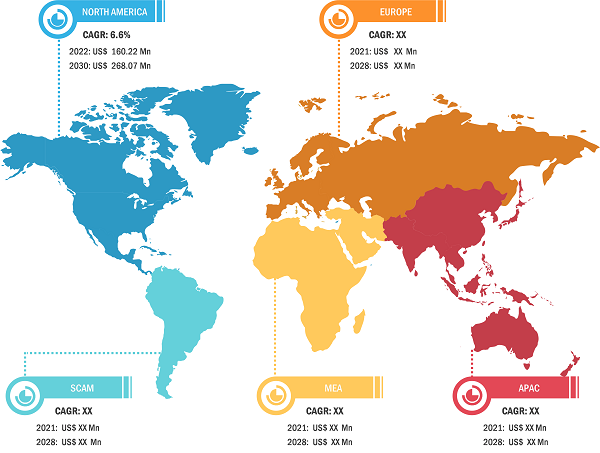Inactivated Vaccine to Dominate Fish Vaccine Market Based on Vaccine Type
According to our new research study on "Fish Vaccine Market Forecast to 2030 – Global Analysis – by Vaccine Type, Application, Route of Administration, and Species," the fish vaccine market size was valued at US$ 355.88 million in 2022 and is projected to reach US$ 617.38 million by 2030. It is estimated to grow at a CAGR of 7.1% during 2022–2030.
Based on vaccine type, the fish vaccine market is segmented into inactivated vaccines, live vaccines, subunit vaccines, recombinant vector vaccine, and others. In 2022, the inactivated vaccines segment held the largest share. The recombinant vector vaccine segment is expected to register the fastest CAGR during 2022–2030. Based on application, the fish vaccine market is classified into bacterial, viral, and parasitic. In 2022, the bacterial segment held the largest share of the market and is expected to register the highest CAGR during 2022–2030. Based on route of administration, the fish vaccine market is segmented into injected, immersion, and oral. In 2022, the injected vaccines segment held the largest share. The immersion segment is expected to grow at the fastest CAGR during 2022–2030. Based on species, the fish vaccine market is classified into salmon, trout, tilapia, and others. In 2022, the salmon vaccines segment held the largest share. The others segment is expected to grow at the fastest CAGR during 2022–2030.

Fish Vaccine Market Insights Report | Size, Share, Scope 2030
Download Free SampleFish Vaccine Market Size and Forecasts (2020 - 2030), Global and Regional Share, Trends, and Growth Opportunity Analysis Report Coverage: By Vaccine Type (Inactivated Vaccines, Live Vaccines, Subunit Vaccines, Recombinant Vector Vaccine, and Others), Application (Bacterial, Viral, and Parasitic), Route of Administration (Injected, Immersion, and Oral), Species (Salmon, Trout, Tilapia, and Others), and Geography (North America, Europe, Asia Pacific, the Middle East & Africa, and South & Central America)
Based on geography, the fish vaccine market is segmented into North America (the US, Canada, and Mexico), Europe (the UK, Germany, France, Italy, Spain, and the Rest of Europe), Asia Pacific (China, Japan, Australia, India, South Korea, and the Rest of Asia Pacific), the Middle East & Africa (Saudi Arabia, South Africa, the UAE, and Rest of the Middle East & Africa), and South & Central America (Brazil, Argentina, and the Rest of South & Central America).
Technological Advancements in Fish Vaccine
Diversifying into new fish species, particularly marine fish, is a trend in the aquaculture sector. Farms across the world are increasingly relying on vaccinations to manage animal health. Novel pathogens with extensive antigenic diversity may also reduce the effectiveness of conventional vaccines. This motivates vaccine researchers to look into new techniques for creating potent vaccines for aquaculture. Subunit or recombinant DNA/RNA particle vaccines may have been created using modern vaccine technology, which is focused on specific pathogen components. Finding new vaccine candidates to fight fish pathogens such as mycotic and parasitic agents is made possible by recent advancements in vaccines and vaccinology. The development and production of fish vaccines can be done rapidly with the help of new techniques in genetics, immunology, and biotechnology. These techniques include the use of genetically engineered vectors, recombinant vaccines, and DNA vaccines.
DNA vaccine technology provides significant protection against fish diseases. Targeting the construct and/or transgene to antigen-receptor cells is a promising way to improve the DNA vaccine's effectiveness against other viral diseases. Molecular assemblies can be used to target dendritic cells (DC) and antigen-presenting cells (APC) in DNA vaccines, producing immune responses as a result. Another tactic is to encapsulate the DNA vaccine in specific carriers to increase transgene and MHC expression.
The development of novel vaccines known as recombinant DNA-based vaccines or new-generation vaccines has made extensive use of R DNA technology. Recombinant immunogenic protein vaccines or epitopes purified from vectors carrying the gene of interest produced in prokaryotic or eukaryotic expression systems, peptide vaccines, live vaccines produced by defined genetic manipulations, and microbial vectors carrying gene coding for immunogenic protein and DNA vaccines are among the types of vaccines based on recombinant DNA technology that have been developed. Recombinant vaccines have the advantage of closely simulating naturally occurring infections, which aids in triggering a potent immune response in the treated fish. They can also be mass-produced easily.
Zoetis Inc., Merck & Co Inc., Hipra SA, Phibro Animal Health Corp, Vaxxinova International BV, Kyoto Biken Laboratories, Elanco Animal Health Inc., Nisseiken Co., Ltd., KBNP Inc., Choong Ang Vaccine Laboratories Co., Ltd., and INDIAN IMMUNOLOGICALS LTD are among the leading companies operating in the fish vaccine market.
Contact Us
Phone: +1-646-491-9876
Email Id: sales@theinsightpartners.com